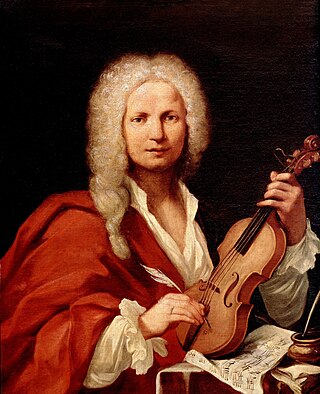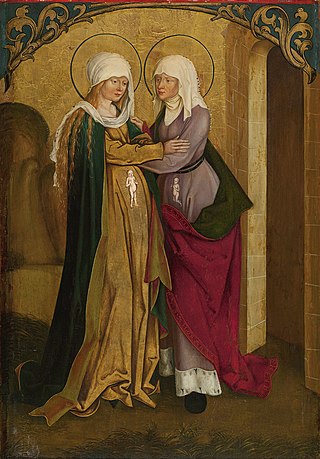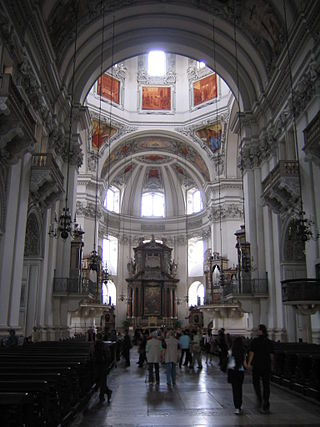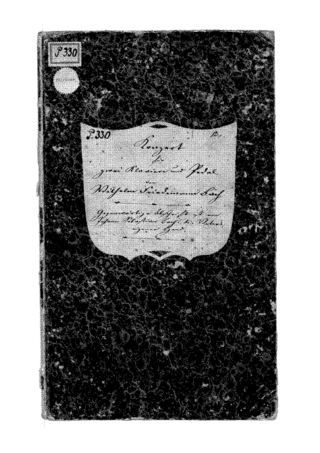Related Research Articles

Antonio Lucio Vivaldi was an Italian composer, virtuoso violinist and impresario of Baroque music. Along with Johann Sebastian Bach and George Frideric Handel, Vivaldi ranks amongst the greatest Baroque composers and his influence during his lifetime was widespread across Europe, giving origin to many imitators and admirers. He pioneered many developments in orchestration, violin technique and programmatic music. He consolidated the emerging concerto form into a widely accepted and followed idiom.

The viola d'amore is a 7- or 6-stringed musical instrument with sympathetic strings used chiefly in the baroque period. It is played under the chin in the same manner as the violin.

Vespro della Beata Vergine, SV 206, is a musical setting by Claudio Monteverdi of the evening vespers on Marian feasts, scored for soloists, choirs, and orchestra. It is an ambitious work in scope and in its variety of style and scoring, and has a duration of around 90 minutes. Published in Venice as Sanctissimae Virgini Missa senis vocibus ac Vesperae pluribus decantandae, cum nonnullis sacris concentibus, ad Sacella sive Principum Cubicula accommodata, it is sometimes called Monteverdi's Vespers of 1610.

In 1724 Johann Sebastian Bach composed the church cantata Meine Seel erhebt den Herren, BWV 10, as part of his second cantata cycle. Taken from Martin Luther's German translation of the Magnificat canticle, the title translates as "My soul magnifies the Lord". Also known as Bach's German Magnificat, the work follows his chorale cantata format.
Antonio Vivaldi wrote at least three Gloria compositions, settings of the hymn Gloria in excelsis Deo, with words probably dating back to the 4th century, and an integral part of the mass ordinary. Two of them have survived: RV 588 and RV 589. A third, RV 590, is mentioned only in the Kreuzherren catalogue and presumed lost. The RV 589 Gloria is a familiar and popular piece among sacred works by Vivaldi. It was probably written at about the same time as the RV 588, possibly in 1715.

Johann Sebastian Bach's Magnificat, BWV 243, is a musical setting of the biblical canticle Magnificat. It is scored for five vocal parts, and a Baroque orchestra including trumpets and timpani. It is the first major liturgical composition on a Latin text by Bach.
An introduzione is a motet for solo voice intended to be sung before certain choral settings of liturgical texts. Eight introduzioni by Antonio Vivaldi survive, each in three or four movements. The texts of introduzioni are non-liturgical but sometimes paraphrase liturgical texts. In the Ryom Verzeichnis, Vivaldi's introduzioni are numbered from RV 635–642.
The Credo in E minor is the only extant setting of the Nicene Creed by Antonio Vivaldi. Another setting exists but is of dubious authenticity.
Nisi Dominus is a setting of the Latin text of Psalm 127 by George Friederic Handel. The name of the piece comes from the first two words of the psalm, and it is catalogued in the composer's complete works as HWV 238. It was completed by 13 July 1707, and is one of a number of works he composed in Italy. It is most likely that Nisi Dominus was first performed on 16 July 1707 in the church of Santa Maria in Montesanto, Rome, under the patronage of the Colonna family.

Vesperae solennes de Dominica, K. 321, is a sacred choral composition, written by Wolfgang Amadeus Mozart in 1779. It is scored for SATB choir and soloists, violin I and II, 2 trumpets, 3 trombones colla parte, 2 timpani, and basso continuo.

Gloria in excelsis Deo, BWV 191, is a church cantata written by the German Baroque composer Johann Sebastian Bach, and the only one of his church cantatas set to a Latin text. He composed the Christmas cantata in Leipzig probably in 1742, for a celebration by the university of Leipzig. The composition's three movements all derive from the Gloria of Bach's 1733 Kyrie–Gloria Mass, which the composer would later use as the Gloria of his Mass in B minor.

Psalm 127 is the 127th psalm of the Book of Psalms, beginning in English in the King James Version: "Except the Lord build the house". In Latin, it is known by the incipit of its first 2 words, "Nisi Dominus". It is one of 15 "Songs of Ascents" and the only one among them attributed to Solomon rather than David.

Vesperae solennes de confessore, K. 339, is a sacred choral composition, written by Wolfgang Amadeus Mozart in 1780. It is scored for SATB choir and soloists, violin I, violin II, 2 trumpets, 3 trombones colla parte, 2 timpani, and basso continuo.

Antonio Vivaldi made several versions of his G minor setting of the Magnificat canticle. He scored his best known version, RV 610, for vocal soloists, four-part choir, oboes and string orchestra, which also exists in a version for two groups of performers. He based these versions on an earlier setting for voices and strings only (RV 610b). His ultimate version, in which some choral and ensemble movements are replaced by five arias, to be sung by girls from the Ospedale della Pietà orphanage, was catalogued as RV 611. The concise work is well suited for use in vesper services.

The Magnificat in E-flat major, BWV 243a, also BWV 243.1, by Johann Sebastian Bach is a musical setting of the Latin text of the Magnificat, Mary's canticle from the Gospel of Luke. It was composed in 1723 and is in twelve movements, scored for five vocal parts and a Baroque orchestra of trumpets, timpani, oboes, strings and basso continuo including bassoon. Bach revised the work some ten years later, transposing it from E-flat major to D major, and creating the version mostly performed today, BWV 243.

The Concerto for Strings in G major, RV 151, commonly referred to as the Concerto alla rustica, is a concerto for orchestra without soloists by Antonio Vivaldi. It was written between mid-1720 and 1730, and is one of the composer's best-known concertos.

The organ concertos of Johann Sebastian Bach are solo works for organ, transcribed and reworked from instrumental concertos originally composed by Antonio Vivaldi and the musically talented Prince Johann Ernst of Saxe-Weimar. While there is no doubt about the authenticity of BWV 592–596, the sixth concerto BWV 597 is now probably considered to be spurious. Composed during Bach's second period at the court in Weimar (1708–1717), the concertos can be dated more precisely to 1713–1714.

Antonio Vivaldi composed three settings of the Dixit Dominus, the Latin version of Psalm 110. They include a setting in ten movements for five soloists, double choir and orchestra, RV 594, another setting in eleven movements for five voices, five-part choir and orchestra, RV 595, and a recently discovered setting in eleven movements for five soloists, choir and orchestra, RV 807, which had been attributed to Baldassare Galuppi. It is said to be one of his "most significant sacred works."

Antonio Vivaldi's Concerto for Two Cellos in G minor, RV 531 is a concerto for two cellos, string orchestra and basso continuo in three movements, believed to have been composed in the 1720s. It is Vivaldi's only concerto for two cellos, and begins unusually with an entry of the solo instruments alone.

Antonio Vivaldi's Concerto for Two Trumpets in C major, RV 537, is a concerto for two trumpets, string orchestra and basso continuo in three movements, believed to have been composed in the 1720s. It is Vivaldi's only trumpet concerto. It was published by Ricordi in 1950 after its manuscript was found in a Turin library.
References
- 1 2 Michael Talbot, CD liner notes for Andreas Scholl – Vivaldi: Nisi Dominus, Decca Records 289 466 964-2
- 1 2 3 "Vivaldi Sacred & Secular program notes", Harriet Smith, Barbican Centre, April 2022]
- 1 2 3 4 "Program notes", Bruce Lamott, Philharmonia Baroque Orchestra and Chorale, San Francisco, December 5-9, 2018
- ↑ Nisi Dominus, RV 803 (Vivaldi) : Scores at the International Music Score Library Project ; RISM 212006305
- 1 2 James Manheim, "Vivaldi: Nisi Dominus", p. 1470, The All Music Guide to Classical Music, Backbeat Books, 2005, ISBN 0-87930-865-6
- ↑ Psalms 127, New King James Version